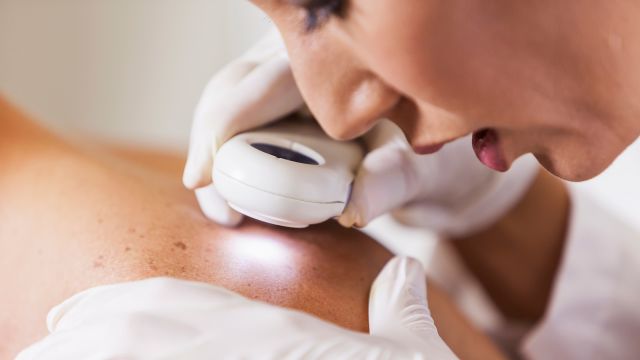Updated on March 19, 2025
Skin cancer is the most common type of cancer in the United States and the most treatable, if caught early. Anyone can develop skin cancer, regardless of their skin color. Knowing more about the different types of skin cancer may help you prevent it or get diagnosed at an earlier stage.
Skin cancer types and symptoms
A noticeable change in the appearance of your skin, such as a growth or persistent dry patch, may be a sign of skin cancer. It often appears on areas of the skin exposed to the sun, such as the face, head, neck, arms, and hands, but it may start anywhere on the body.
Basal cell carcinoma
The most common type of skin cancer, basal cell carcinoma (BCC), usually looks like pearly, shiny, pink, or white bumps on lighter skin tones. On darker skin, the bumps may appear glossy black or brown. BCC may also appear as a dark blue or black lesion, a flat and scaly patch of skin, or waxy and white without a clear border. Roughly 8 of 10 skin cancers are BCC, according to the American Cancer Society (ACS). These cancers grow slowly and may recur in the same place if not completely removed.
Squamous cell carcinoma
Squamous cell carcinomas (SCC) are the second most common type of skin cancer. They’re usually rough and crusty and may look like a pink, red, black, or brownish bug bite or pimple. The area might be swollen and scaly, leak fluid or bleed, and may feel itchy, tender, or painful. This type of skin cancer is a bit more likely to grow into deeper layers of the skin and spread than BCC.
Melanoma
This type of cancer accounts for about 1 percent of skin cancers but is responsible for the majority of skin cancer deaths, according to ACS. Melanoma is usually brownish in color and looks like a mole, often with irregular borders. “Melanoma has the tendency to spread throughout the body. That’s why it’s so deadly,” explains James DeVito, MD, a dermatologist in Englewood, Colorado.
Actinic keratoses
These are dry, scaly patches that are considered precancerous. If left untreated, they may develop into SCC.
Risk factors for skin cancer
Exposure to natural sunlight and tanning beds both increase the risk of skin cancer. “We know that all of these cancers occur by ultraviolet exposure, and there’s clearly a genetic risk factor,” says Dr. DeVito.
Other risk factors for skin cancer include:
- Fair, light skin
- Red or blonde hair
- Blue or green eyes
- Irregular moles or lots of moles
- Skin that sunburns, freckles, or reddens easily or becomes painful when exposed to the sun
- History of blistering sunburns as a child or teen
- Family or personal history of skin cancer
Your skin cancer risk increases as you grow older, as well.
Diagnosing skin cancer
“Most of the time, we can diagnose skin cancer clinically, pretty much by looking at it,” says DeVito. If a healthcare provider (HCP) suspects skin cancer, they will perform a biopsy to ultimately determine if the mark or lesion is cancerous. A biopsy involves removal of a small piece of skin to be examined more closely under a microscope.
If you notice a suspicious-looking mark or mole on your skin, see an HCP. “We want patients to be on the lookout for moles that look different,” says Dr. DeVito.
Follow the ABCDEs at home to check yourself for melanoma:
- A: Asymmetry refers to a mole that’s different on each side, meaning the sides don’t match and don’t form a balanced circle or shape.
- B: Border refers to a mole with an uneven border at the edges.
- C: Color refers to a variety of colors or shades in the mole.
- D: Diameter refers to a mole that’s larger than usual (bigger than a pencil eraser).
- E: Evolving refers to a mole that’s changing over time. For example, it goes from flat to raised or changes color.
Preventing skin cancer
Make skin cancer prevention a daily habit, all year around. When you’re outside, use a physical sunscreen—a broad-spectrum, water-resistant sunscreen with either zinc oxide or titanium dioxide—of at least SPF 30. Apply it to areas of the skin not covered by clothing, ideally about 30 minutes before heading outdoors. Reapply every two hours or right after swimming or doing activities that cause you to sweat excessively.
Other tips that could help you prevent skin cancer include the following:
- Further protect your skin outdoors by seeking shady areas and wearing light clothing that covers the skin, hats with a broad brim, and sunglasses with ultraviolet protection.
- Avoid indoor tanning beds.
- Perform head-to-toe skin self-exams in front of a full-length mirror to check for signs of skin cancer every month.
- Get annual mole checks, either by an HCP or dermatologist.
- If you notice any spots on your skin that look new or unusual or that itch or bleed, make an appointment with a board-certified dermatologist as soon as you can.
Treatment for skin cancer
Most skin cancer is surgically treated, says DeVito. The skin is numbed, and the skin cancer is removed with a small surgical blade or scraping tool. Mohs surgery is a special procedure that’s done in stages so that your HCP can check the area to make sure all the cancer cells are removed.
BCC and SCC are sometimes burned off if small enough, and topical treatments (ointments and creams) are available, as well. In addition, SCC may be treated by freezing, phototherapy (a special liquid or gel is applied to the affected skin and then exposed to light), or laser therapy. All of these treatments help to destroy the cancer cells on the skin.
Depending on the type of skin cancer and the extent of its spread, the following may be used for treatment in some cases:
- Radiation therapy, which uses high-energy rays (like X-rays) to destroy cancer cells
- Chemotherapy, or drugs that kill cancer cells or slow their growth
- Immunotherapy, which uses drugs to boost the immune system
- Targeted therapy, or drugs that target specific parts of cancer cells to stop their growth and spread
The earlier a skin cancer is identified, the earlier you can be treated, and the better the potential outcome. Remember to speak with an HCP right away about any suspicious moles or marks on your body.




